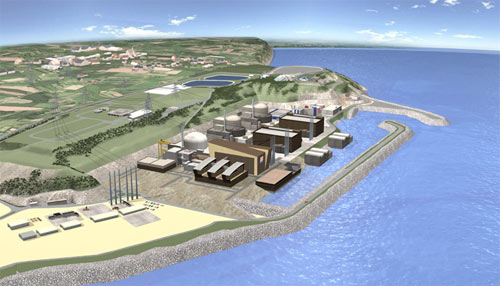EPR: a third generation pressurized water reactor

The first French EPR at Flamanville
The first EPR in France will be installed at the site of Flamanville west of Cherbourg, taking over the two existing PWR. On this reconstitution of the future site, the dome of the EPR appears at the bottom of the hill in front of the smaller domes of the two PWR reactors. The ensemble is integrated discretely into the landscape, the plant being visible only from the sea
EDF
Third generation reactors are reactors intended to replace the today operating reactors. Their design cannot be considered as new but as the culmination of the present pressurized and boiling water reactors that precede them.
One of these reactors is the EPR (European Pressurized water Reactor) of which the first unit was commissioned by Finland in 2003 and a second is planned in France for the Flamanville site. The finland EPR is now in operation (2022). The french EPR is foreseen in 2023. Others under construction in China are operating since 2018. The EPR is an enhanced version of the last French and German pressurized water reactors. It is the result of the collaboration of EDF and Framatome-ANP, a joint venture of Areva and Siemens.
Should nuclear power expands, the EPR will provide a good transition for the arrival of the so-called fourth generation reactors that will follow. It will produce electricity without emitting greenhouse gas and will generate the fissile material needed to start a fleet of fast breeder reactors.
Great efforts have been made with the EPR to improve safety: a double barrier ensuring the containment of radioactive materials in case of serious accident such as the fusion of the core ; redundant safety and reactor control devices intend to prevent the consequences of a malfunction or an attack, each of the devices being able to control alone by itself the reactor.
The reactor would be cleaner and its performance in terms of environment would be improved compared to existing nuclear plants. Compared with the last 1300MW power units, the thermal energy loss from the Flamanville reactor will be lower, for an equal amount of electricity produced, due to yield improvement. In addition, the chemical releases are to be divided by two and the radioactive waste reduced by 30% (excluding carbon 14 and tritium). The reduction of radioactive waste would also be of 30% due to improved yield and increased rate of combustion (burn-up).

EPR overview
The reactor building houses the primary circuit constituted mainly of the tank (1), steam generators (2), pressurizer (3) and primary pumps (4). The turbine building (13) houses the equipment that converts steam into electricity. If the power of the plant was to be cut, diesel engines, located in two separate buildings (11), will be able to provide the electricity necessary for safety functions. Operators command the plant from the control room (12) located in one of the safeguard buildings.
AREVA
The EPR could contribute to the stabilization of the stocks of plutonium thanks to an efficient recycling of this fissile element. Its more flexible functioning would allow diversity in the choice of fuel. Although the possibility will not be used during the first years of operation of the Olkiluoto and Flamanville reactors, it could burn a nuclear fuel including up from 15 to 50% of MOX (a nuclear fuel recycling plutonium).
Despite the cost of an increased security, the EPR could be more economical and efficient than the most recent PWR. These gains in competitiveness would result from a yield of 37% instead of 34%, a better use of the fuel (the rate of combustion or energy per ton of fuel would be increased from 45 to 60 GWd / ton) and a size effect (electric power from 1550 to 1600 MWe for each phase instead of 1450). The expected lifetime of these reactors would be 60 years instead of 40.
What the EPR does not ? It is not a breeder: the consumption of uranium-235 (fissile) remains too high for sustainable development of nuclear power. In addition, it would not burn minor actinides that it generates unlike fourth generation reactors that could do it. A park made exclusively of pressurized water reactors would not eliminate the long-lived waste. It must be associated with specialized reactors for the incineration of minor actinides, such as hybrid reactors.
Other articles on the subject « Future Reactors »
Generation III Reactors
The reactors of tomorrow before those of after tomorrow Designed in the 1990s, third-generation r[...]
The nuclear option ?
Energy challenge : meeting energy demands of the Future The emergence of huge future needs by de[...]
Generation IV
Towards a fourth generation of reactors To meet the formidable challenges of sustainable developm[...]
Molten Salt Reactors
Promising reactors … but in a remote future Molten Salt Reactors are very different in desi[...]